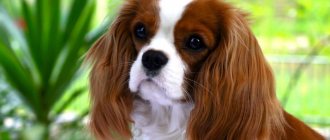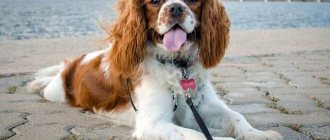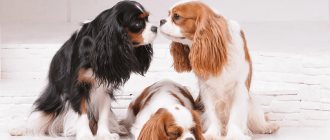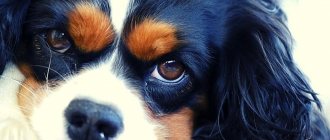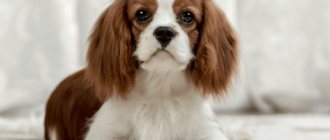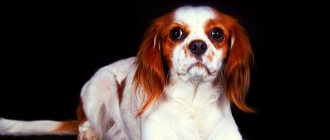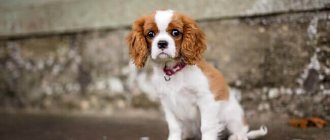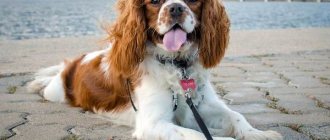Many people, both single people and families, have pets. Some people prefer cats, hamsters, parrots, while others have a dog in the house. Dogs are distinguished by the fact that they are the easiest to train. In addition, they have protective qualities, which is very important. Nowadays, there is a wide choice of dog breeds that best suit your specific needs.
The Cavalier King Charles Spaniel dog breed can be a good companion for its owner. This breed can be recommended to active and cheerful people, as well as families with children. This dog is in great demand among older people, who are often bored due to lack of exercise. These dogs can literally “light up” the most inactive old people, forcing them to look at the world differently.
This breed has a fairly docile character, not showing aggression towards humans, and always tries to please its owner, depending on his mood. The British are sure that this breed perfectly relieves stress, creating comfort and coziness in a person’s home. These dogs can be recommended to people who are very tired at work, both physically and psychologically. Many families, both in the UK and in Holland, keep similar dogs at home also because this breed is also noble.
Breed card
- Famous breed names: Cavalier King Charles Spaniel, Cavalier, King Charles
- FCI breed number: 136
- Description of the standard on the FCI website: link
- Height at withers: up to 33 cm
- Adult dog weight: up to 8 kg
- Color options: Blenheim, ruby, tricolor, black and tan
- Lifespan: 10-12 years
- Puppy cost: from 15,000 to 40,000 rubles
- Size: 1 of 5
- Learning ability: 4 out of 5
- Attitude towards children: 5 out of 5
- Shedding intensity: 2 out of 5
- Protective and guard qualities: 1 out of 5
Sample menu for the week
| Day of the week | Morning | Evening |
| Monday | 100 g beef, 50 g greens, and 100 g oatmeal + 1 tsp. vegetable oil | 150 g turkey, 100 ml kefir, 200 g vegetables |
| Tuesday | 150 g of boiled sea fish, 100 ml of natural yogurt and 100 g of stewed vegetables with 1 tsp. vegetable oil | 100 g beef, 100 g cottage cheese and 100 g buckwheat porridge |
| Wednesday | 150 g offal, 100 ml kefir and 50 g herbs | 250 g offal, 80 g cottage cheese and 80 g stewed vegetables with 1 tsp. vegetable oil |
| Thursday | 150 g cottage cheese, 30 g herbs and 1 egg | 300 g beef, 100 g stewed vegetables and 80 g rice porridge |
| Friday | 150 g offal, 100 ml kefir and 50 g herbs | 250 g offal, 80 g cottage cheese and 80 g stewed vegetables with 1 tsp. vegetable oil |
| Saturday | 150 g of boiled sea fish, 100 ml of natural yogurt and 100 g of stewed vegetables | 100 g beef, 100 g cottage cheese and 100 g buckwheat porridge |
| Sunday | 100 g beef, 50 g greens, and 100 g oatmeal | 150 g turkey, 100 ml kefir, 200 g vegetables |
Characteristic
The International Federation of Cynologists classifies the breed as a decorative breed and places the dogs in the spaniel section. The gentleman is active, affectionate and trusting of others, calm. He is not inclined to show aggression or increased excitability.
Breed standard FCI No. 136
According to the standard, the Cavalier Spaniel is a compact, well-built dog with a small head, a wedge-shaped filled muzzle and a flat skull. The muzzle ends with a black nose with prominent nostrils, well-developed lips tightly covering strong jaws with a perfect full scissor bite.
Large, bulging eyes are set widely apart, the color of the iris ranges from dark brown to black. The ears are set high on the head, covered with abundant fur with fringes.
The straight line of the back ends with a straight croup and a tail decorated with lush hair. When excited, the tail rises above the line of the back, and carries down when moving. The King Charles moves calmly and elegantly, and when running it pushes off sharply with its hind legs.
A breed fault is considered to be any deviation from the standard in the appearance or character of a dog.
Dimensions, weight and height of the breed
The standard defines the Cavalier King Charles Spaniel as a well-proportioned dog, but does not specify exact height parameters. On average, the height at the withers, characteristic of representatives of the breed, is up to 33 cm. The permissible weight according to the standard is 5.4-8 kg.
Cavalier King Charles Spaniel: photo, description, character, price
Possible colors
The Cavalier Spaniel's coat is silky and soft, lying in a light wave, but not curly. Decorating hair grows abundantly on the ears, limbs and tail. Trimming is not required for exhibitions.
Four types of coat colors are acceptable:
- Blenheim - pearly white with chestnut spots;
- tricolor - white with red and black spots on the ears, limbs and cheekbones;
- black and tan - orange markings on eyebrows, chest, paws and cheekbones;
- ruby – a solid, bright red hue.
The Blenheim color is characterized by a diamond-shaped marking of a chestnut shade in the central part of the forehead.
Puppy weight by month
King Charles Spaniel puppies develop differently. The parameters for matching the age and weight of the puppies below are approximate. You can use them as a guide, but don’t worry if your dog gains weight more slowly.
Weight-for-age for the Cavalier King Charles Spaniel:
- 1 month – 900 g;
- 2 months – 1.4-2 kg;
- 3 months – 2.2 kg;
- 4 months – 2.5 kg;
- 6 months – 3.6 kg;
- 9 months – 4.3 kg
- 12 months – 4.5-6 kg.
Lifespan
Cavaliers live up to 12 years, like most decorative dogs. In order for your pet to feel good even in old age, he needs to be provided with a balanced diet and a sufficient level of activity.
Allergenicity
The King Charles Spaniel has little undercoat and practically does not shed. Allergy sufferers should talk to a dog of this breed before purchasing, and to make sure that a reaction does not occur, contact an allergist.
Cavalier King Charles Spaniel: photo, description, character, price
How to choose? Boy or girl?
You should not buy a King Charles Spaniel puppy from someone else or from an advertisement. Only professional breeders in specialized nurseries can guarantee the purity and health of pets.
At about 30-40 days after birth, the puppies are weaned from their mother, and at 8-12 weeks they are ready to go to a new home.
IMPORTANT!
It is important that the puppy meets the breed standard and has no defects in appearance or developmental abnormalities. He should not have a rash, increased lacrimation, swelling on the joints or ribs, twisted limbs, dandruff, lameness and other symptoms of the development of pathologies.
Representatives of this breed already have pronounced sexual dimorphism at an early age - males have a larger head and a compact body, while females are more graceful, but their body is more elongated, which is due to the need to bear offspring. The character of a dog does not depend on gender.
History of the breed
There are two theories about the origin of the Cavalier King Charles breed. According to the first, in the 11th century, during the reign of King Canute, dogs similar to spaniels were brought to Britain, where they were used for hunting. Later, the handsome spaniels were appreciated by families of aristocrats and began to have them as palace dogs.
The second theory connects the Cavalier's ancestors with Italian small dogs, which were brought to England by the knight Fitz-Ralph from the crusade.
It is reliably known that Cavalier King Charles Spaniels have been popular in England since 1554. They were indispensable companions of rich families of that time. During the reign of Elizabeth I, small dogs lived in the palace, brought joy to their owners, and confirmed their high status to those around them. In the 14th-17th centuries. King Charles spaniels were depicted on their canvases by famous painters - Titian, Jean Watteau and others.
The breed's greatest popularity came during the reigns of Kings Charles I and Charles II. The latter adored his dogs - they were allowed to enter any part of the palace and even attend meetings of the British House of Commons. The dog got its elegant name from King Charles.
The first toy spaniel club was created in 1886 in England. The first dog shows began to be organized at the end of the 19th century, and at the same time they were actively engaged in breeding. As a result of breeding work, the breed gradually began to lose its original appearance, and in 1926 a group of English enthusiasts under the leadership of Roswell Elridge decided to revive it. At the Craft show they created a separate class of dogs similar in type to the original King Charles type, and established a prize for the best match. In 1928, the prize was awarded to a male named Anns Son. It was he who became the founder of the breed - in 1945, a standard was drawn up from the dog, approved by the English Kennel Club. At the same time, Cavalier Spaniels were exported to New Zealand, America and other countries, where they quickly gained popularity.
Choosing a nickname
Oddly enough, but choosing a worthy nickname for a girl or boy of this breed is quite difficult. On the one hand, the dog is cheerful, spontaneous and active, which dictates the choice of a simple and affectionate name. On the other hand, being "royalty" requires a name that sounds like a title.
Names with Japanese or Chinese sounds have become popular among the owners of these dogs.
For girls : Akana, Rowena, Akina, Yukki, Shinuka.
For boys : Locky, Rockwell, Tuxie, Amethyst, Rocky, Lando.
Photo: wikimedia.org
Character
The Cavalier King Charles Spaniel is a gentleman. He does not force communication, but loves to be the center of attention. The dog is great for large families in which someone constantly communicates with him. Left alone for a long time, the spaniel becomes apathetic and loses interest in games and walks. In the absence of its owners, it barks and whines, expressing sadness.
He loves to travel with his owners, both short distances - to the store or on a visit, and long distances. Easily adapts to the pace of life of any person. He is friendly towards strangers, but sometimes shows timidity in communication. Therefore, a cavalier puppy requires socialization from childhood. He gets along easily with other pets, but does not allow himself to be offended - he bites his oppressors.
From time to time, a hunting instinct manifests itself in its character - the dog happily chases moving objects, snatches away sticks and toys, and chases cats into trees with joyful barking.
Cavalier King Charles Spaniel - description of the breed
Advantages and disadvantages
Based on the experience of Cavalier owners, one can highlight the pros and cons inherent in the breed, which will help the future owner decide on the desire to purchase just such a pet.
pros
- incredibly dedicated and faithful;
- do not need constant long walks, although if they are accustomed to them they will only be happy;
- the wool is hypoallergenic and does not smell like dog;
- They love children, but are also great for older people;
- get along well with any pets.
Minuses
- they themselves are severe allergy sufferers and have a large list of breed pathologies;
- are often too annoying;
- can afford to bite;
- great owners can “appropriate” any economic item and it will not be possible to take it away.
Photo: pexels.com
Learning ability
The cavalier should be taught a standard set of commands. Thanks to his inquisitive mind, he can be trained quickly, especially if the owner uses positive reinforcement.
Spaniels are most receptive to training between the ages of one month and six months. During this period, special attention should be paid to raising the puppy. Establish a set of rules in the house and demand their implementation. Before training, the baby must learn a nickname, then get used to the leash and collar.
The commands are introduced sequentially - training begins in a calm environment with the commands “Sit!” and “Lie down!”, then “To me”, “Near” and others are added. When the skill is consolidated, complications are introduced - endurance and distractions.
The spaniel is sensitive to the intonations in the owner's voice - all commands must be given in an even and clear voice, without shouting. Be sure to joyfully praise after a successful exercise and encourage it with a treat. The worst punishment for this dog is the owner's harsh tone; spanking, even weak, is unacceptable.
Education and training
These dogs have very developed intelligence, so they quickly understand and learn commands. However, after a certain time, the spaniel may stop following the owner's commands due to boring activities.
Dog handlers advise training to be carried out in the form of active play, constantly introducing variety and acting exclusively with affection.
Since the dog has quite developed hunting instincts, during a walk a representative of the royal breed can find an object to pursue. Therefore, you need to teach the dog basic commands - “come”, “fu”.
It is necessary to raise an animal from the first days of its appearance in the house, because often such pets take part in exhibitions. From the age of five months, it is necessary to accustom the puppy to the show stand. Initially, the position is reinforced with encouragement, and as soon as the baby understands the essence, he is taught the command “stand!”
Experienced handlers advise dividing the training of the command “stand!” and “sit!” by time. First, the dog must master the command that fixes him in the stance, otherwise at a crucial moment he may confuse the commands.
Content
You can keep a Cavalier King Charles Spaniel in an apartment or in a private house. The main thing is to provide the dog with a warm bed away from drafts.
Need for physical activity
The spaniel does not require much physical activity, although it can run around the street all day. The optimal duration of a walk in warm seasons is half an hour, in winter – 15-20 minutes. In the cold season, be sure to dress the dog in warm overalls and periodically pick it up while walking, giving it the opportunity to warm up.
During pregnancy, the bitch's walking routine should not be changed - at the end of the pregnancy she herself will not want to walk too far. The only thing you should do is reduce physical activity. Starting from the fourth week of pregnancy, it is forbidden to bathe the bitch - after a walk you can only wipe her paws.
Cavalier King Charles Spaniel - photo, breed description, price
Appearance care
The coat of the Cavalier King Charles Spaniel should be brushed with soft brushes twice a week and washed once a month. When washing, use insecticidal shampoos to prevent the formation of fleas.
To avoid the appearance of ear mites, it is necessary to inspect your pet's ears every day and wipe them weekly with a cotton pad soaked in a chlorhexidine solution.
If dark discharge appears from the ears, the dog should be taken to the veterinarian.
Discharge from the eyes should be removed daily with a soft cloth, and a cleaning lotion from a veterinary pharmacy should be instilled into the eyes twice a week. Brush your teeth with a soft brush; in addition, you can give your dog treats to clean his teeth.
Claws should be trimmed with a nail clipper as they grow. In the summer, while walking on the asphalt, they wear down on their own, and in the winter they require maintenance.
Nutrition
Owners of King Charles Spaniels carefully control the diet of their pets - the dogs are allergic and prone to obesity.
Dry food is selected taking into account the breed characteristics, trying to ensure that the composition does not contain chicken and wheat. A natural diet is formed on the basis of boiled meat and cereals, adding vegetables and low-fat fermented milk products. Never give your dog sweets, fatty and smoked foods, bones, exotic fruits and spices.
Application
The main purpose of a gentleman for several centuries has been to be a companion. He will not make a watchman or security guard - the pet loves people too much.
Moreover, this is not a dog of one owner. He is equally gentle and courteous with all family members, their relatives, friends and passers-by. Some owners scold their “traitors,” but that’s their character.
The dog can be used for short hunting or its imitation. He willingly picks up a bird, chases wild rodents, and “fishes.”
Typical diseases of this breed
The most common disease in cavaliers is heart disease, mitral regurgitation. It can occur at any age and is characterized by a heart murmur.
Other breed diseases:
- allergy;
- diabetes;
- arthritis;
- hernia;
- dislocation of the kneecap;
- retinal dysplasia.
Buying a puppy
To buy a Cavalier puppy, find breed clubs and breeders in your city. Find litters ready for sale and study the pedigrees of the parents. Ask the breeder questions about typical diseases of the breed and possible difficulties. Answer his questions about the future conditions of keeping the puppy.
Examine the litter and choose the puppy with the best conformation and personality traits. A promising puppy must have:
- well developed nostrils;
- sloping forehead;
- large eyes, widely spaced;
- scissor bite;
- arched neck;
- normal muscle tone;
- the behavior of a “gentleman” is a calm attitude towards others, adequate communication with fellow humans.

